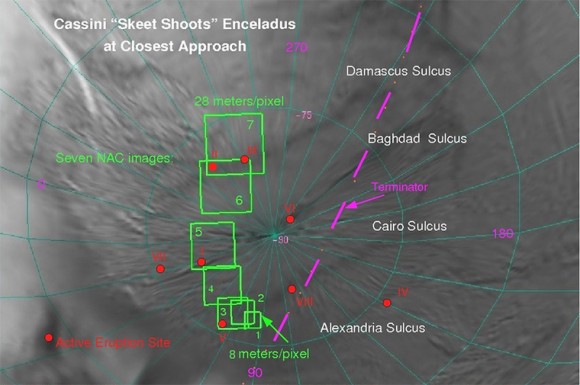Scientists for the Cassini mission called their flyby of Saturn’s small moon Enceladus on August 11 a “skeet shoot,” partially in honor of the current Olympic games underway, but mostly because the spacecraft would be trying to shoot rapidly at the moon with its array of cameras and scientific instruments. As the images begin to stream back, the scientists are definitely excited about what they’re seeing.
“What a dazzling success!” said Carolyn Porco, the Cassini Imaging Team Leader. “There doesn’t even appear to be any smear.” Scientists compared Cassini’s fast flyby of Enceladus to trying to capture a sharp, unsmeared picture of a roadside billboard about a mile away with a 2,000 mm telephoto lens held out the window of a car moving at 50 mph. The imaging team is still poring over the pictures to see if they were successful in “shooting” their target: the active vent regions on the tiger stripe-like features on the moon’s south pole that create the geysers on Enceladus. But the amazingly clear images show a fractured surface littered with boulders and what Porco said could possibly be ice blocks.
Cassini flew over the surface of Enceladus at tremendous speed; about 18 km/sec (about 40,000 mph), which makes taking clear images very difficult. The imaging team devised a technique of turning the spacecraft while taking pictures in rapid succession, shooting at seven, very high priority surface targets. The suite of images ranged in resolution from 8 to 28 meters/pixel, using exposure times that were long enough to see the surface in the twilight near the terminator yet short enough to avoid smear.

The tiger stripes, officially called sulci, have been identified by the imaging cameras on earlier flybys of Enceladus as the sources of the jets, and also as the “hot spots” or warmer areas on the moon identified by the Cassini’s Composite Infrared Spectrograph.

Porco said the team still has much work to do to decipher all the information in the images and data from the other instruments. “In this painstaking work, we proceed, step by step, to lay bare those things which hold the greatest promise of comprehension, the greatest significance for piecing together the story of the origins of the bodies in our solar system, our Earth, and indeed ourselves,” she wrote in her blog.
We’ll provide further updates on the flyby images as information becomes available.
Sources: Cassini’s website, NASA blogs, CICLOPS flyby preview


Congrats to the imaging team! Looks like the skeets were blasted in the first try. 🙂
Stunning images. Look at the boulders and small details. Way cool!
Another amazing work 🙂 for the Cassini team
Truly great work.
Fantastic.
On the lower right side of the first picture there are crater like formations running along a crack. Its not the craters that surprise me its the amount of them all lined up and following the crack even when the crack curves they still follow. Can someone please explain what would cause this.
Amazing shots!!!
Best mission since Voyager ; congratulations to Nasa & Esa, here’s one thing where they’ve had vision, ambition & most importantly didn’t mess up!
Great pics, but can you do me a favor and flip this image?
The light is coming from the wrong direction and all I see are retarcs, skcarcs, and llihs.
Wow! Amazing!
If only we could get pictures like that of all (or most) of our solar system’s moons!
How about a round of applause for the trajectory team, who managed to get so close while slowly moving towards a 70 degree inclination!
Well done!
spectacular, cassini , wondrous job.
Cassini is a helluva spacecraft, and this wonderful success only emphasizes that.
And from this distance, Enceladus looks a whole lot like Europa. A truly bizarre little world…
As bad as NASA has dropped the ball with manned spaceflight, its robotic missions are top notch.
A lot less “political friction” and interference with unmanned projects.
“Can someone please explain what would cause this.”
Lots and lots of water! We have about 5 lander targets now among the saturnian and jupiterian moons alone. Start working on some RTG submarines as well.
Amazing. It never fails to surprise me how varied and thoroughly interesting the surfaces that the various solar system bodies possess can be.